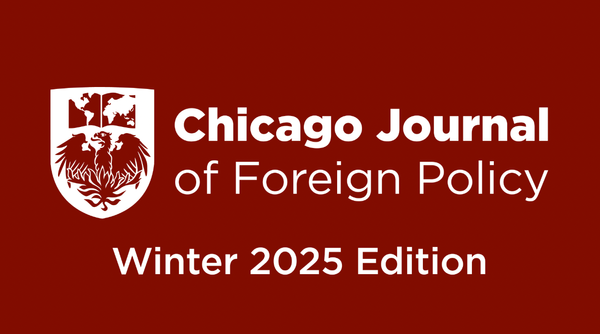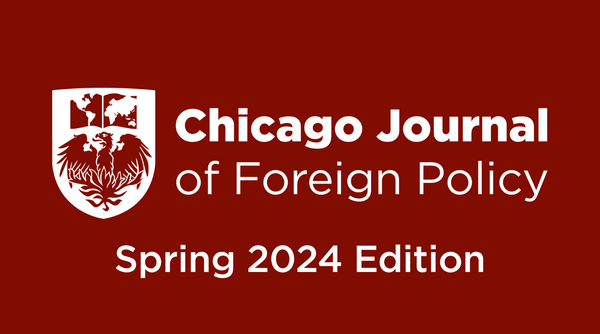Ensuring Gracefulness in Withdrawals: The dynamics of the Early 1970s American Withdrawal from South Korea
By Juan Leal Mendoza, University of Chicago[1]
This article appeared in CJFP's Winter 2024 publication.
Abstract
The Nixon administration’s partial withdrawal from South Korea in 1971 was unprecedented for American peacetime foreign policy in East Asia. It can be partially attributed to Nixon’s ambition to implement the Nixon Doctrine, Congressional inclination to do some military cuts, and America’s quasi-isolationist mood during the latter stages of the Vietnam War. Hence the successful implementation and eventual support from South Korea was also unprecedented, yet, a matter with little coverage in American foreign policy.
This research explored the feasibility of peacetime withdrawals by large states from their allies, or “graceful” withdrawals, and developed three parameters to explore the institutional, bilateral and leverage factors that affect said withdrawals. Through government documentation research (particularly that of the Nixon Library and the History of the Foreign Relations of the United States [FRUS] database), academic analyses, and an understanding of the contemporary regional patterns, this research found that the 1971 withdrawal’s success came from a combination of effective American posturing (insofar as objectives, consulting and aid offered to South Korea to make up for the withdrawal), poor South Korean negotiation tactics, and greater political pressures going on at the time (originating from the Nixon doctrine’s goals and the US congress). Thus, South Korea’s initial hostility towards the withdrawal gradually shifted towards reluctant acceptance and compliance.
Barring a few exceptions, the United States got what they wanted from this withdrawal, while South Korea reluctantly eased demands until the final agreements strongly favored the US. Graceful withdrawals are possible through credible pre-existing motivators, ensuring agreement between the two allies, countering a host country’s halting influence, and robust planning with “carrot-and-stick” tactics that compel ally participation. However, it is difficult to ensure a graceful withdrawal when allies may disagree and attempt to push back or disrupt the withdrawal timeline. Again, these factors shaped US withdrawal attempts from Korea in 1978 and 1991, which can be examined through similar lenses on the basis of the given parameters.
Context
The end of the 1960s was a time of significant geopolitical change in East Asia. As the Vietnam War raged on in Southeast Asia, the recently sworn-in Nixon administration was looking for ways to reduce the US’s global military commitments and spending. This thinking led President Nixon to announce the Nixon doctrine in a press conference on July 25, 1969. At its core the doctrine ensured US honor to pre-existing regional commitments and encouraged American allies to take initiative in their self defense.[2] With this, the Nixon administration and South Korea’s President Park Chung-Hee approached East Asian foreign policy with hope of becoming mutual benefactors.In August of 1969, President Park and Nixon held a meeting in San Francisco, California to reaffirm the continuum of good relations between the two nations following the Vietnam War. South Korea’s aid in raising American forces to 50,000 men by 1969 caused for a surprising US withdrawal from South Korea. [3]
The Withdrawal
On November 24, 1969, President Nixon instructed National Security Advisor Henry Kissinger to begin organizing a withdrawal plan for up to half of America’s soldiers in South Korea.Naval/air forces were to be kept to the minimum level required for a “retaliatory strike.”[4] Cooperation between the National Security Council, Joint Chiefs of Staff, the Departments of Defense and State, and the American embassy at Seoul instated three key pillars for the withdrawal plan: 1) The withdrawal of 20,000 American troops from South Korea by the end of Fiscal Year 1971 (FY 1971); primarily 18,400 men from the US 2nd Infantry Division and 1,600 men from temporary US Air Force deployments, , 2) A modernization aid plan for South Korea’s armed forces, mainly through Congress-approved Military Assistance Programs (MAP) worth $200 million per year for FYs 1971-75, and 3) Consulting with the Park government to ensure the withdrawal is done in the most agreeable and organized manner possible (and thus reaffirm America’s continuous commitment to South Korea and the Mutual Defense Treaty).[5] The US also looked to minimize the possibilities of their troops being in immediate crossfire at the start of a potential inter-Korean conflict, retaining only one brigade US presence in the Panmunjom section of the Demilitarized Zone.[6] The plan accounted for National Security Study Memorandum 27’s (NSSM 27) Korea’s situational baselines and the National Security Directive Memorandum 48’s (NSDM 48) official withdrawal order, which ordained three months of planning and a nine month withdrawal plan through the three pillars.[7]
Immediately following Nixon’s decision, Park privately expressed his aggrievement , emphasizing that South Korea was unequipped to face North Korea’s threats independently. Additionally the withdrawal would increase the likelihood of a conflict in the North Korean peninsula.[8] Discussions between Park’s and Nixon’s governments were primarily handled by American Ambassador William J. Porter in Seoul;viz. July of 1970, a military leadership summit in Honolulu, Hawaii, alongside a visit by Vice President Agnew to Seoul the month after.[9] Through these meetings, South Korea’s grievances with the withdrawal were heard (hence, the consultations pillar), while the assistance plan’s specifics were negotiated, (the military assistance pillar) and respectable withdrawal announcements for the nation public were drafted. South Korean resistance to the withdrawal slowly mellowed into specific caveats, most notably through South Korea’s proposed “Agreed Minutes” document, which primarily served to explicitly link South Korean input into future American troop size decisions on the peninsula.[10] This document did not go far, and ultimately, the nine-month American withdrawal process began on February 5, 1971, with a joint communique announcing a continuous commitment to the mutual defense of both countries, all while further MAP aid arrived to South Korea.[11]
Parameters
This research can be used to project the potential successes of graceful withdrawals done between allied patron and protégé states under peacetime conditions. These parameters demark how key factors in patron-protégé relations impact decision making in graceful withdrawals. The parameters are:
- Institutional Motivators: Whether either of the countries (particularly within the patron) have internal forces advocating for a patron force withdrawal.
- Bilateral Agreement: Level of agreement between the patron and the protégé that the withdrawal is viable at the time.
- Protégé Leverage: How much influence does the protégé have towards the patron to alter or even stop the withdrawal.
As a general rule, for a graceful withdrawal to succeed, Institutional Motivators and Bilateral Agreement should be as strong as possible, while Protégé Leverage ought to remain as weak as possible (and vice versa for all three for withdrawal to be halted). In turn, the combination of parameters and strengths create a multifaceted way to interpret possible outcomes for a graceful withdrawal. Historically graceful withdrawals are plausible, including the focus of this research, from which these parameters and their strength orders can be tested.
Table 1: Summarizing different grades for the three parameters of graceful withdrawals
|
|
Institutional Motivators |
Bilateral Agreement |
Protégé Leverage |
|
Strong |
When
either country (particularly the patron) has compelling reasons behind the
withdrawal; blunts domestic opposition. Strengthens the chances of a graceful withdrawal. |
Public and private agreement
between the two countries on the feasibility of the withdrawal. Strengthens the
chances of a graceful withdrawal. |
Protégé has compelling mechanisms
to influence the patron’s withdrawal. Weakens the chances of a
graceful withdrawal. |
|
Medium/Moderate |
Some influences in either country
are pushing for a withdrawal, but their importance is debatable. Fluctuating/muted
effect on the chances of a graceful withdrawal. |
Protégé is in the process of
changing its stance on the withdrawal while the patron’s stance remains
consistent OR when contradictions between public and private stances of
either of the countries slows down, but doesn't stop, negotiations. Fluctuating/muted
effect on the chances of a graceful withdrawal. |
Protégé has mechanism(s) that
affects or modifies, but doesn’t disrupt, the patron’s withdrawal process. Fluctuating/muted
effect on the chances of a graceful withdrawal. |
|
Weak |
When either country (particularly
the patron) does not have compelling reasons to engage in the withdrawal;
stirs domestic opposition. Weakens the chances of a
graceful withdrawal. |
Either country presents a
committed and consistent opposition to the withdrawal. Weakens the chances of a
graceful withdrawal. |
Protégé does not have compelling
mechanisms to influence the patron’s withdrawal. Strengthens the
chances of a graceful withdrawal. |
Note: The coloring choice used to show whether a course of action improves or weakens the chances of a graceful withdrawal is not meant to show an author preference towards a specific course of action or policy, but rather use an easily accessible color association scheme for the audience.
Findings
There were multiple factors that contributed towards South Korea’s eventual public acceptance of the withdrawal, which can be attributed to both American and Korean behavior, and can be interpreted through the three parameters. America’s posturing was the central motivator for Korea’s acceptance of the withdrawal, primarily through carrot-and-stick tactics. As described in NSDM-48, the US would consult and provide 5 year’s worth of military modernization aid to South Korea to make the withdrawal process as amiable as possible. This aid was meant to assuage Korean worry of a messy withdrawal, endangering South Korean stability and security.[12] Vice President Agnew announced during his August 1970 visit to Seoul a supplementary $150 million package to be delivered at the start of the modernization timeline; this was intended as a sign of commitment to improve and modernize 18 South Korean divisions and overall defense capabilities.[13] Per war games organized by the US Joint Chiefs of Staff, this modernized South Korean force, alongside one-and-a-third of the American division that would stay after the withdrawal, would be enough to hold back a North Korean and/or combined DPRK-Chinese attack from taking Seoul for a period of up to 30 days.[14] Therefore, US modernization aid was planned with the intention that South Korea would have the means to defend itself for enough time for further American reinforcements to arrive, and the one-and-a-third American division in the Korean Peninsula would be the tripwire to guarantee a deterrence effect on North Korea. Despite fluctuating visions regarding the two nations in the withdrawal, American assistance meant there was sufficient medium level Bilateral Agreement to bring the withdrawal forward as planned.
Furthermore, the US’s consulting offers meant that the South Koreans held some initiative in shaping the nature of the withdrawal process. Though it’s worth noting, that America’s offers did not equate to an absolute guarantee to heed to all of South Korea’s requests, or disrupt the Nixon administration’s internally agreed pillars. For instance, the United States was not willing to accept Park’s request for $3 billion in aid in FY 71-75, despite the total aid from the US went up from NSDM-48’s $1 billion to $1.5 billion in MAP grants and equipment.[15] Additionally, South Korea’s refusal to participate in consultations regarding the timing of the withdrawal meant the United States had to handle the timeline unilaterally. Despite no delay, Ambassador Porter classified the situation as “regrettable”.[16]
While American negotiation tactics were precise, South Korea’s lack of positioning left them stranded. This is best shown in FRUS’s Document 88, Footnote 5, where Ambassador Porter explains that the combination of Park’s non-cooperative attitude toward American withdrawal and his policy of decentralizing South Korean negotiating meant his ministers had to negotiate difficult and inflexible objectives while chasing the physical commencement of the withdrawal on February 5, 1971[17] As the deadline approached, Park’s Ministers were pressured to bear good news, thus working themselves into a situation pre-coded by the US. . For reference, the positioning of the “Agreed Minutes” joint communique; the Americans interpreted one clause as giving South Korea veto power on future US troop movements in the peninsula by having the US pledge that it had “no intention” to act against South Korea’s interests, and another clause as requiring yearly consulting meetings between the two country’s officials.[18] American officials rejected the former clause (alongside any other clause that required new binding commitments) but approved a minimized version of the latter clause as South Korea ran out of time to renegotiate. Ambassador Porter’s narrative and the evolution of the “Agreed Minutes” communique demonstrates South Korea’s ineffectiveness at producing Protégé Leverage due to Park’s ineffective negotiation tactics. South Korea’s position was weakened by this, while the Americans found favorable terms in the final agreements.
However, it is also worth noting that as the protégé state, South Korea had no true leverage in these negotiations. A patron state can withdraw its troops from its protégé at any time it wishes, with or without compensation aid involved. Protégé Leverage can deter withdrawals, but it is overruled if the patron ultimately deems the necessity of the withdrawal trump to the possible damage on their relationship with the protégé. This speaks to the Realist and Alliance Management schools of thought of International Relations; emphasizing that a foreign commitment is outdated as soon as a nation’s vested interest in the region falters- further weakening South Korea’s case towards the Protégé Leverage parameter. Park’s government already had reached an unideal scenario by having the withdrawal happen at all, as he understood that the US, had the unilateral power to dictate the fate of its own troops. Unless South Korea increased its leverage over the US through high risk measures (be it through factors such as domestic influence within the US or threatening that South Korean troops would fully withdraw from Vietnam should the America withdrawal happen), it is unlikely an improvement in negotiation tactics would have made up for this fundamental political imbalance between the two countries.
Finally, there are two other important factors in predicting graceful withdrawals, as evaluated through the parameters and this case study. First off, as previously discussed, graceful withdrawals are different from other military withdrawals (such as those at the end of a war) insofar that the former is based on peace conditions, a lack of imminent external threats in the region where the withdrawal takes place. For these baseline conditions to be upheld, favorable external conditions are needed, particularly as it relates to hostile external actors and/or the perception of a lack of an imminent existential threat for the protégé. Should such conditions not be upheld, a graceful withdrawal may tip into a crisis situation, where the proposed graceful withdrawal becomes a tug of war of words and threats between the patron and the protégé. This would not be the case out of malice, but rather the realization by either, but not both, of the parties engaged in the withdrawal that undertaking it could pose a grave security risk for the protégé. This realization of a “separating line” between a graceful and a potential crisis outcome is a gray that can lead to major consequential changes in bilateral behavior, and thus would be the second predicting factor in exploring graceful withdrawals. Conditions needed to prevent a crisis outcome are important enough to mention in this report, however, what constitutes the “separating line” between a graceful withdrawal and a potential crisis outcome is beyond the scope of this research.
The Parameters Assessed
These three parameters for graceful withdrawals, now applied in depth for a specific case, can be tested on further withdrawal attempts in South Korea by the US, even beyond the 1971 case study. For example, the 1978 US withdrawal attempt by the Carter Administration can be correctly deduced to have failed as it had weak institutional motivators present (A campaign promise by President Carter), little Bilateral Agreement on the withdrawal’s circumstances or justifications, particularly due to the hostility between Carter and Park, and finally, South Korea had more prominent Protégé Leverage than in 1971 after the Koreagate scandal, in which the Korean Central Intelligence Agency used intermediaries to channel bribes to US congressmen so to influence American policy making, particularly towards US military presence in Korea.[19] On the other hand, President Bush’s 1991 withdrawal can be correctly deduced to have succeeded as it had strong Institutional Motivators and Bilateral Agreement under the context of the end of the Cold War and rising Anti-American sentiment in South Korea, all while South Korea’s Protégé Leverage as had lessened since 1978, but not as dramatically low as in 1971.[20] While these two cases could be examined in a closer manner beyond this paper, the 1971 case study can be used as an outline for such endeavors. The three parameters cannot provide certainty for an specific outcome, they help evaluate and project probable outcomes for graceful withdrawal attempts based on its surrounding characteristics, particularly towards patron and protégé characteristics.
Conclusion
The 1971 American withdrawal from South Korea ended in mutual agreement because South Korea had no option but to shift its position to one that matched the United States’s expectations of what was acceptable, while the US gave political and economic incentives for South Korea to do such a shift. On the basis of the three parameters for gracious withdrawals, while there was a medium level of Bilateral Agreement on the withdrawal’s basis, the US’s strong societal & governmental Institutional Motivators and South Korea’s weak negotiation tactics & consequential Protégé Leverage put Nixon’s plan towards a path of success. Furthermore, the US’s offer for consultation and military aid did not give South Korea leverage within the withdrawal process, but rather ensured that the withdrawal did not jeopardize bilateral relations nor did it endanger South Korean national security, as a compensation-less withdrawal would likely have. The US also showed a continuous commitment to South Korean security through both public statements (even if they were non-binding and written the exact way the US wanted) and implicit assurances the US tripwire force in South Korea remained as is. As such, both nations retained their commitment for mutual security, the withdrawal did not present major changes in their bilateral relations, and the Nixon Doctrine received a credibility boost.
However, this episode did leave important lessons for South Korea, particularly regarding negotiating and influencing American decision making – themes that would come back in Korean-American relations through Koreagate and the future withdrawal attempts by Presidents Carter and Bush Sr. in 1978 and 1991, respectively. [21] Overall, for a patron country to have a graceful exit from a protégé country, the patron must use their higher leverage to incentive participation from the protégé, and solidify this by having the protégé engage in the decision making process to ensure a mutual understanding of the withdrawal’s dynamics- from the timeframe of the withdrawal to coordinating public statements and anywhere in between. Finally, this research’s impact could be expanded in two prongs. First, on the 1971 South Korea withdrawal itself, the research can be expanded insofar to analyzing if this withdrawal had any direct impacts on the pace of South Korea’s withdrawal from Vietnam, and additionally, through which means was the American withdrawal was initially announced to the South Korean public- a major point of contention between the countries’s officials during the negotiations. Additionally, as previously mentioned for the graceful withdrawal parameters, the accuracy of that mechanism can be boosted by researching the exact “separating line” between graceful military withdrawals and potential crisis outcomes.
[1] Advised by Professor Eugene Gholz - University of Notre Dame, Department of Political Science.
[2] Nixon, Richard. “Informal Remarks in Guam with Newsmen.” The American Presidency Project, 25 July 1969. presidency.ucsb.edu/documents/informal-remarks-guam-with-newsmen.
[3] “81. Memorandum of Conversation.” Foreign Relations of the United States, 1969–1976, Volume XIX, Part 1, Korea, 1969–1972, 2 December 1970. history.state.gov/historicaldocuments/frus1969-76v19p1/d81; “35. Memorandum of Conversation.” Foreign Relations of the United States, 1969–1976, Volume XIX, Part 1, Korea, 1969–1972, August 21, 1969. history.state.gov/historicaldocuments/frus1969-76v19p1/d35.
[4] “45. Memorandum From President Nixon to the President’s Assistant for National Security Affairs (Kissinger).” Foreign Relations of the United States, 1969–1976, Volume XIX, Part 1, Korea, 1969–1972, 24 November 1969. history.state.gov/historicaldocuments/frus1969-76v19p1/d45.
[5] “National Security Decision Memoranda 48.” Richard Nixon Presidential Library and Museum, 20 March 1970. nixonlibrary.gov/sites/default/files/virtuallibrary/documents/nsdm/nsdm_048.pdf.
[6] United States Department of Defense, Deputy Secretary. “NSDM 48: U.S. Programs in Korea [Attached to Forwarding Memorandum; Includes Attachment]”. ProQuest, 20 June 1970. proquest.com/dnsa_ko/docview/1679044296/BE815501503644BEPQ; United States National Security Council, Staff. “Korea Decisions [Includes Action Memorandum and National Security Decision Memorandum for President Nixon].” ProQuest, 11 March 1970. proquest.com/dnsa_ko/docview/1679060589/BE815501503644BEPQ.
[7] “National Security Study Memorandum 27.” Richard Nixon Presidential Library and Museum, 22 February 1970. nixonlibrary.gov/sites/default/files/virtuallibrary/documents/nssm/nssm_027.pdf; Richard Nixon Presidential Library and Museum, “National Security Decision Memoranda 48.”; United States Department of Defense, Deputy Secretary. “NSDM 48: U.S. Programs in Korea [Attached to Forwarding Memorandum; Includes Attachment]”.
[8] “46. Memorandum From the President’s Assistant for National Security Affairs (Kissinger) to President Nixon.” Foreign Relations of the United States, 1969–1976, Volume XIX, Part 1, Korea, 1969–1972, 25 November 1969. history.state.gov/historicaldocuments/frus1969-76v19p1/d46.
[9] “67. Telegram From the Commander in Chief, Pacific (McCain) to the Department of State.” Foreign Relations of the United States, 1969–1976, Volume XIX, Part 1, Korea, 1969–1972, 23 July 1970. history.state.gov/historicaldocuments/frus1969-76v19p1/d67.
[10] “74. Telegram From the Department of State to the Embassy in Korea.” Foreign Relations of the United States, 1969–1976, Volume XIX, Part 1, Korea, 1969–1972, 26 October 1970. history.state.gov/historicaldocuments/frus1969-76v19p1/d74.
[11] “88. Memorandum From John H. Holdridge of the National Security Council Staff to the President’s Assistant for National Security Affairs (Kissinger).” Foreign Relations of the United States, 1969–1976, Volume XIX, Part 1, Korea, 1969–1972, 5 February 1971. history.state.gov/historicaldocuments/frus1969-76v19p1/d88; United States Department of Defense, Deputy Secretary. “NSDM 48: U.S. Programs in Korea
[Attached to Forwarding Memorandum; Includes Attachment]”.
[12] United States Department of Defense, Secretary and United States Department of State, Secretary. “NSSM 27--Possible Withdrawal of U.S. Division.” ProQuest, 25 February 1970. proquest.com/dnsa_ko/docview/1679060499/BE815501503644BEPQ/
[13] United States National Security Council, Under Secretaries' Committee. “Modernization of Republic of Korea Armed Forces [Attached to Forwarding Memorandum; Includes Tables].” ProQuest, 19 August 1970. https://www.proquest.com/dnsa_ko/docview/1679060512/BE815501503644BEPQ/
[14] “52. Memorandum From the Joint Chiefs of Staff Representative to the National Security Council Review Group (Unger) to the Chairman of the Review Group (Kissinger).” Foreign Relations of the United States, 1969–1976, Volume XIX, Part 1, Korea, 1969–1972, 17 February 1970. history.state.gov/historicaldocuments/frus1969-76v19p1/d52.
[15] “70. Memorandum From the President’s Assistant for National Security Affairs (Kissinger) to President Nixon.” Foreign Relations of the United States, 1969–1976, Volume XIX, Part 1, Korea, 1969–1972, 22 August 1970. history.state.gov/historicaldocuments/frus1969-76v19p1/d70.
[16] “68. Telegram From the Embassy in Korea to the Department of State.” Foreign Relations of the United States, 1969–1976, Volume XIX, Part 1, Korea, 1969–1972, 4 August 1970. history.state.gov/historicaldocuments/frus1969-76v19p1/d68.
[17] Foreign Relations of the United States, 1969–1976, Volume XIX, Part 1, Korea, 1969–1972, “88. Memorandum From John H. Holdridge of the National Security Council Staff to the President’s Assistant for National Security Affairs (Kissinger).”
[18] “73. Telegram From the Department of State to the Embassy in Korea.” Foreign Relations of the United States, 1969–1976, Volume XIX, Part 1, Korea, 1969–1972, 26 Oct. 1970, history.state.gov/historicaldocuments/frus1969-76v19p1/d73.
[19] Scalapino, Robert Anthony. The United States and Korea: Looking ahead. Center for Strategic
and International Studies, Georgetown University: Sage Publications, 1979; Taylor, William J., Jennifer A. Smith, and Michael J. Mazarr. “US TROOP REDUCTIONS FROM KOREA, 1970–1990.” The Journal of East Asian Affairs 4, no. 2 (1990): 256–86. http://www.jstor.org/stable/23254020.
[20] Taylor, William J., Jennifer A. Smith, and Michael J. Mazarr. “US TROOP REDUCTIONS
FROM KOREA, 1970–1990.”
[21] Scalapino, Robert Anthony. The United States and Korea: Looking ahead, 8.





